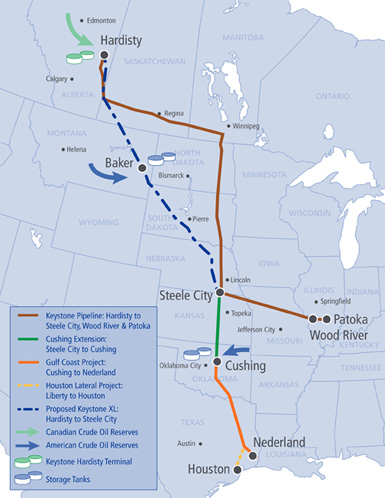For the first time there is now a direct link for Canadian crude oil to the Gulf refineries. The original Keystone pipeline (Phase 1 of the project) originates from Hardisty, Alberta, through Regina, Saskatchewan, and into Manitoba before crossing the border into North Dakota then through South Dakota and into the oil terminals in Steele City, Nebraska. From there the Canadian crude oil originally went to Patoka and Wood River, Illinois. A spokesman for TransCanada Corp. reported “some 550 million barrels of oil have been shipped via pipeline into Patoka and Wood River since the pipeline became operational in 2010.”
Phase Two
The second phase of the Keystone pipeline was the completion of the 300-mile leg from Steele City to Cushing, Oklahoma. Finally, in late January of this year, the Gulf Coast Pipeline Project went operational and Canadian crude oil moved from Cushing to Nederland, Texas.

“We are now actually connected all the way to the Gulf Coast,” said TransCanada Corp. CEO Russ Girling. “The shippers (on the Keystone line) have the ability to not only deliver at Cushing, they can deliver right through to the Gulf Coast. “
Other Developments
In addition to the opening of the Gulf Coast pipeline, there have been major developments with regard to Keystone XL. In early February, the State Department released its latest report on the proposed XL pipeline. The report found that the pipeline’s construction would create as many as 3,900 jobs over two years. The additional spending on construction material would push the job gain up to 4,200 — counting jobs building the pipeline. More importantly, the report found that the construction of the pipeline would not harm the environment.
This final environmental review by the U.S. State Department further found that the Keystone XL pipeline would not greatly increase carbon emissions because the oil sands in Alberta would be developed anyway. And, according to an article in Forbes, “Environmental risks from hypothetical future pipeline spills need to be weighed relative to what is likely to happen if the oil travels by an alternative pipeline across Canada or by train south into the U.S.” It’s noted that there have been six accidents in the past year involving trains carrying oil.
The study is important because President Obama has said he would not approve Keystone XL if it would exacerbate carbon pollution. Now, according to Bloomberg, “The pipeline’s fate comes down to the broader questions about whether the project is in the U.S. national interest, weighing matters such as energy needs and diplomatic relations.”

